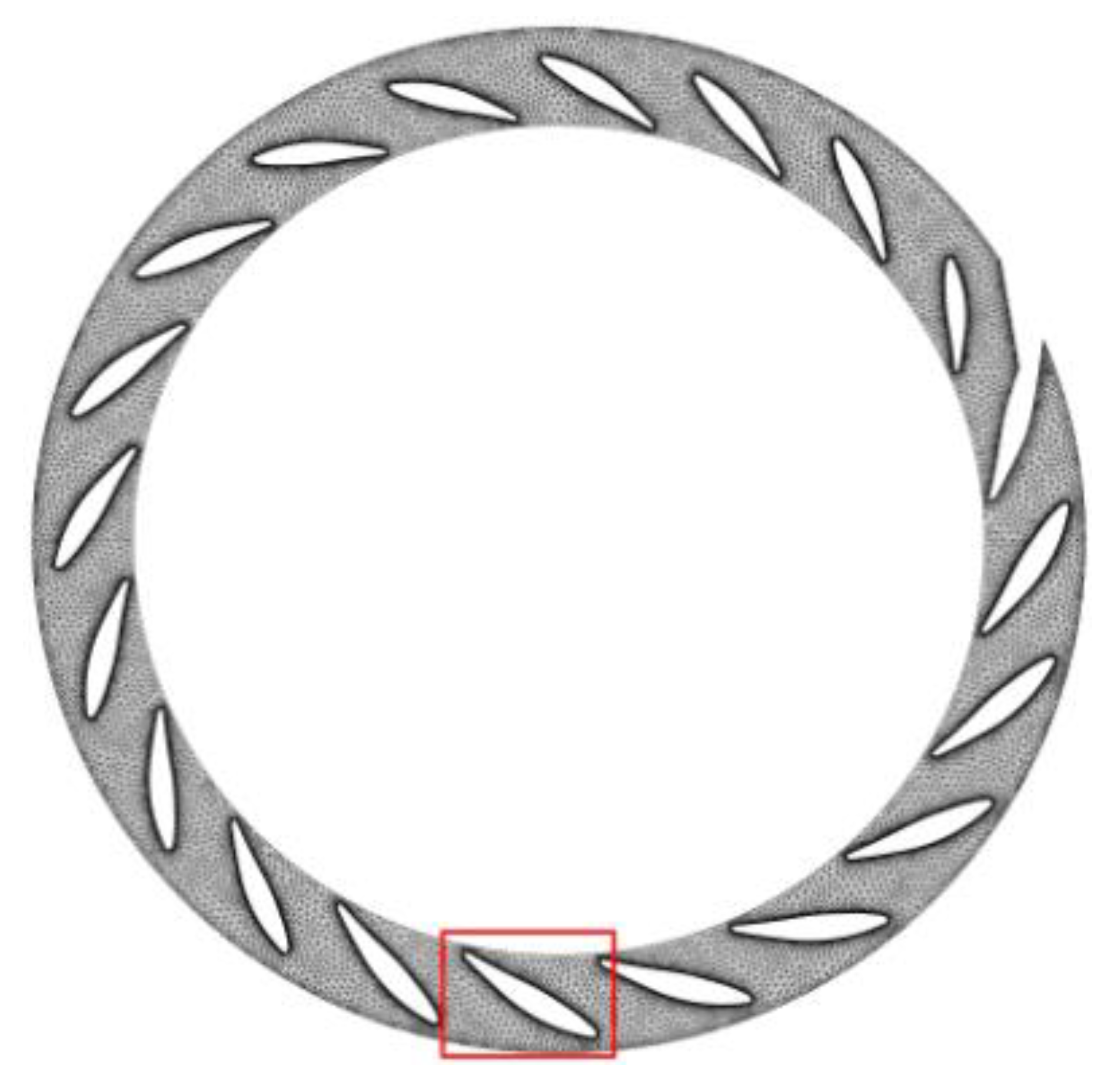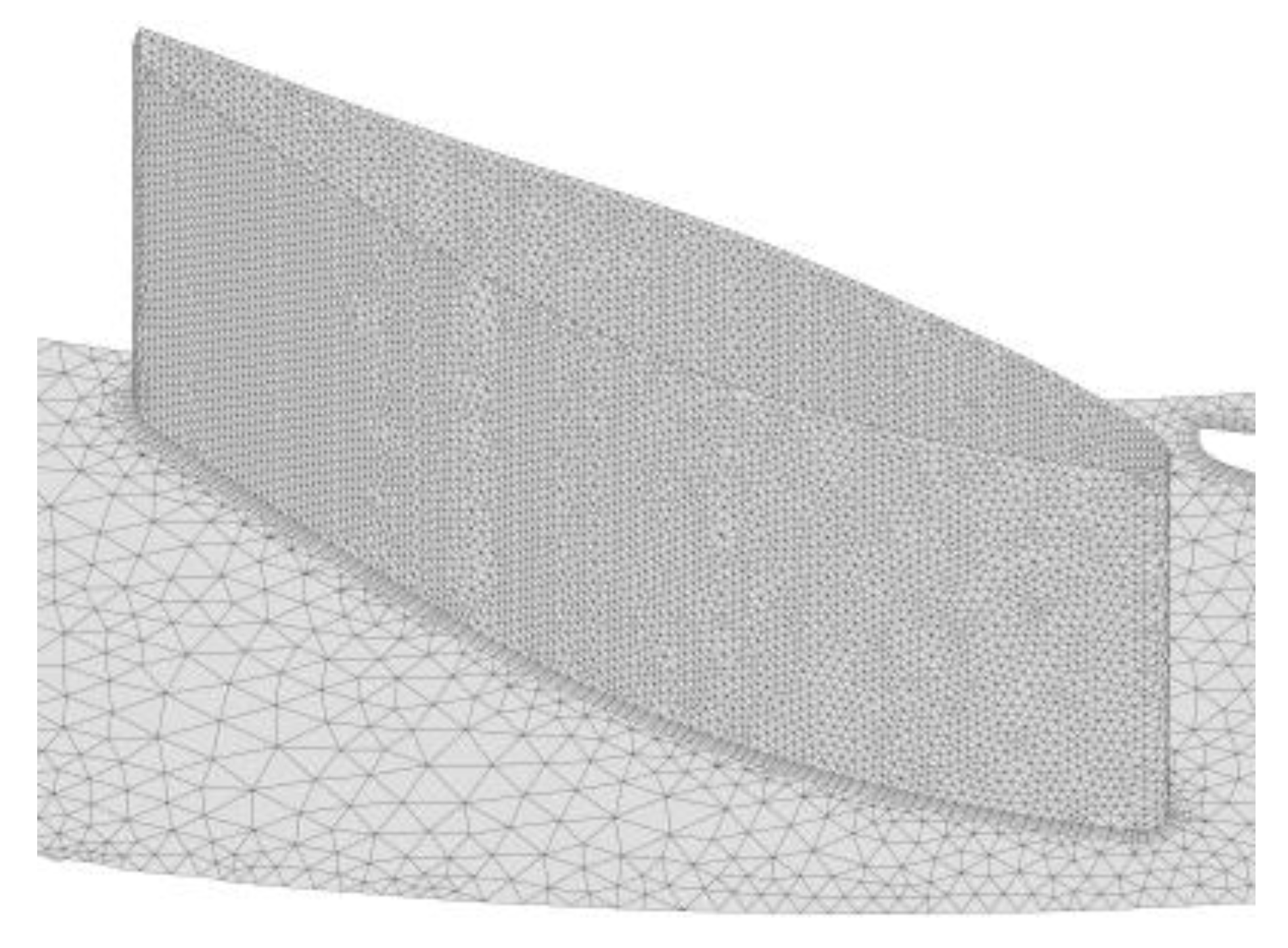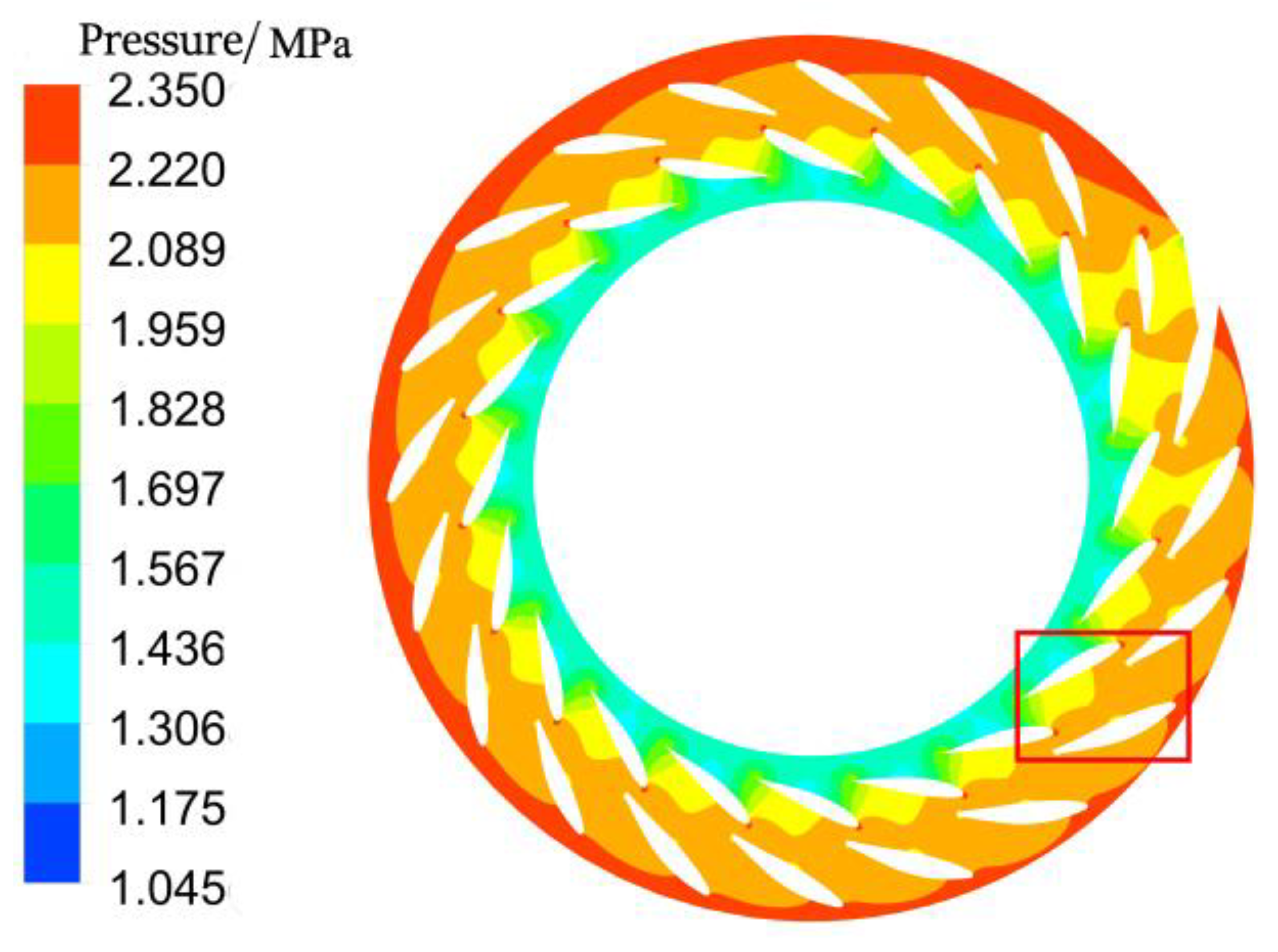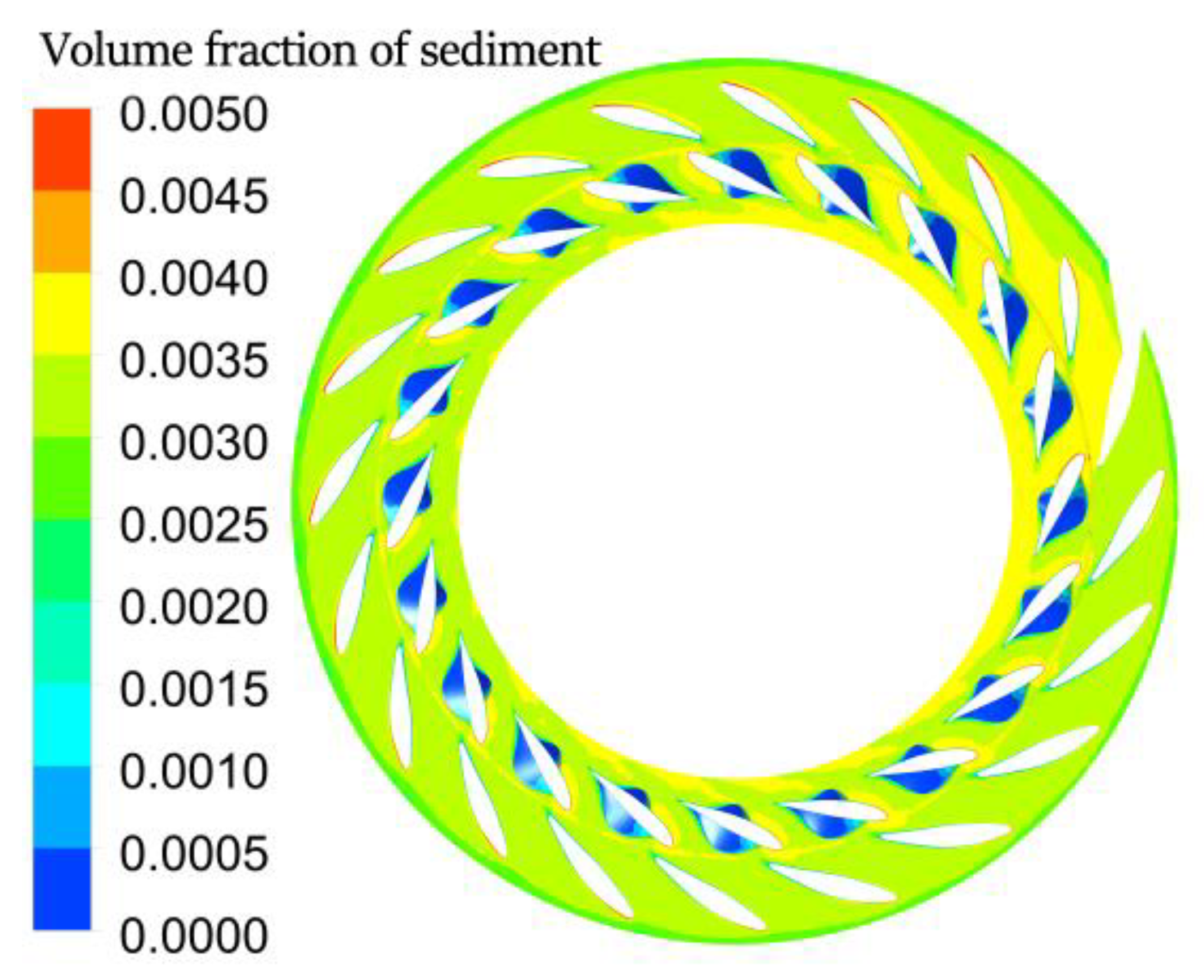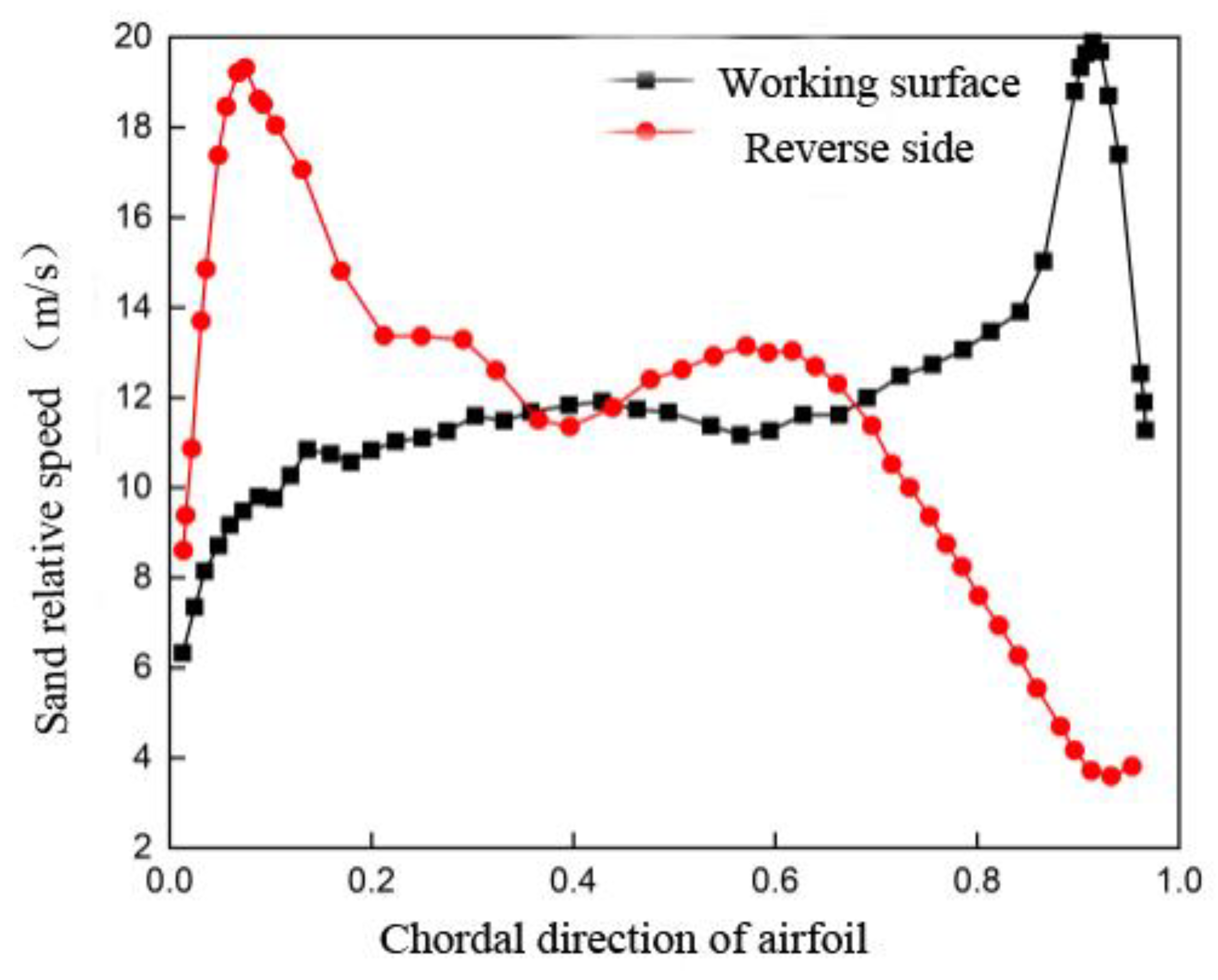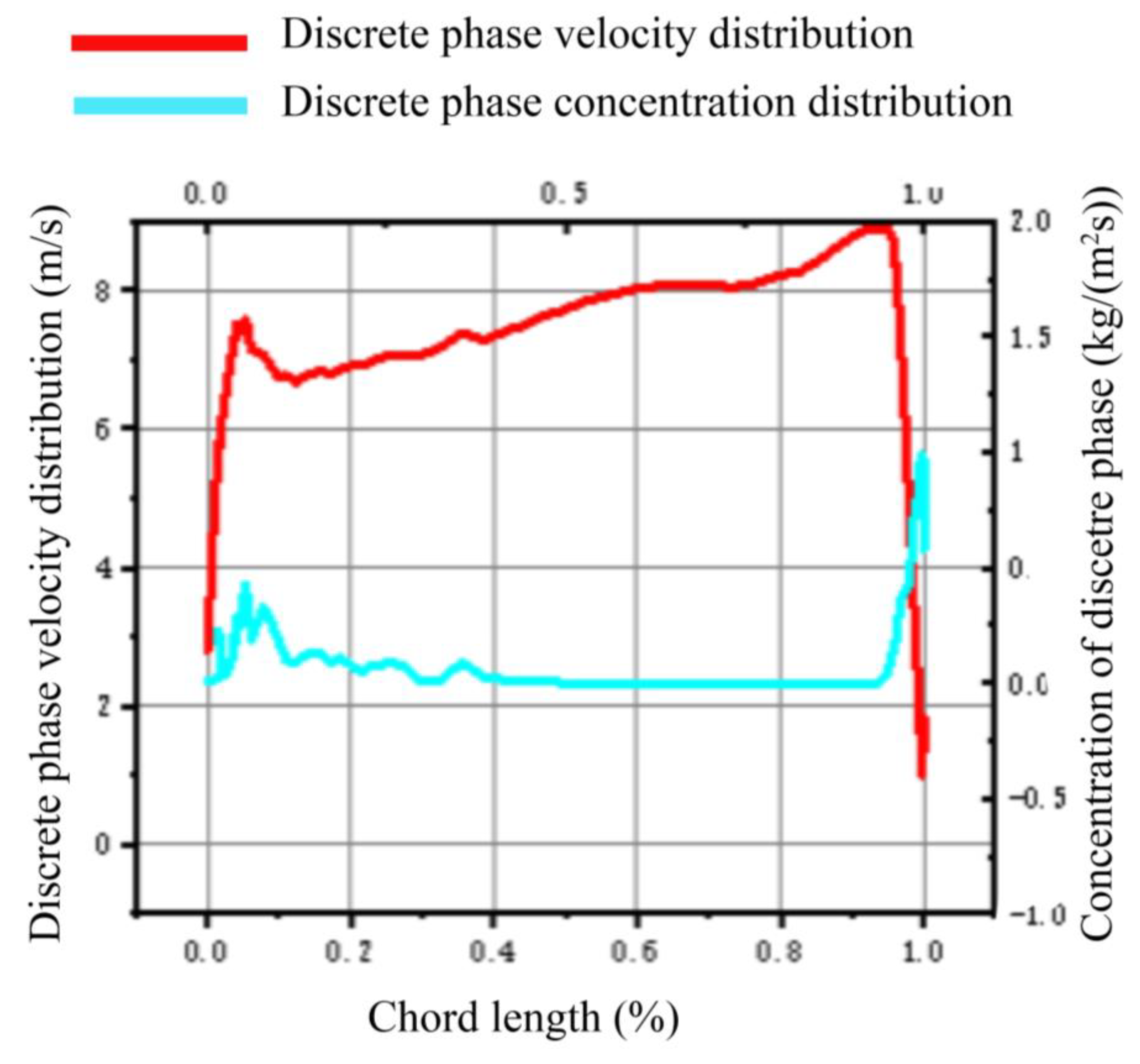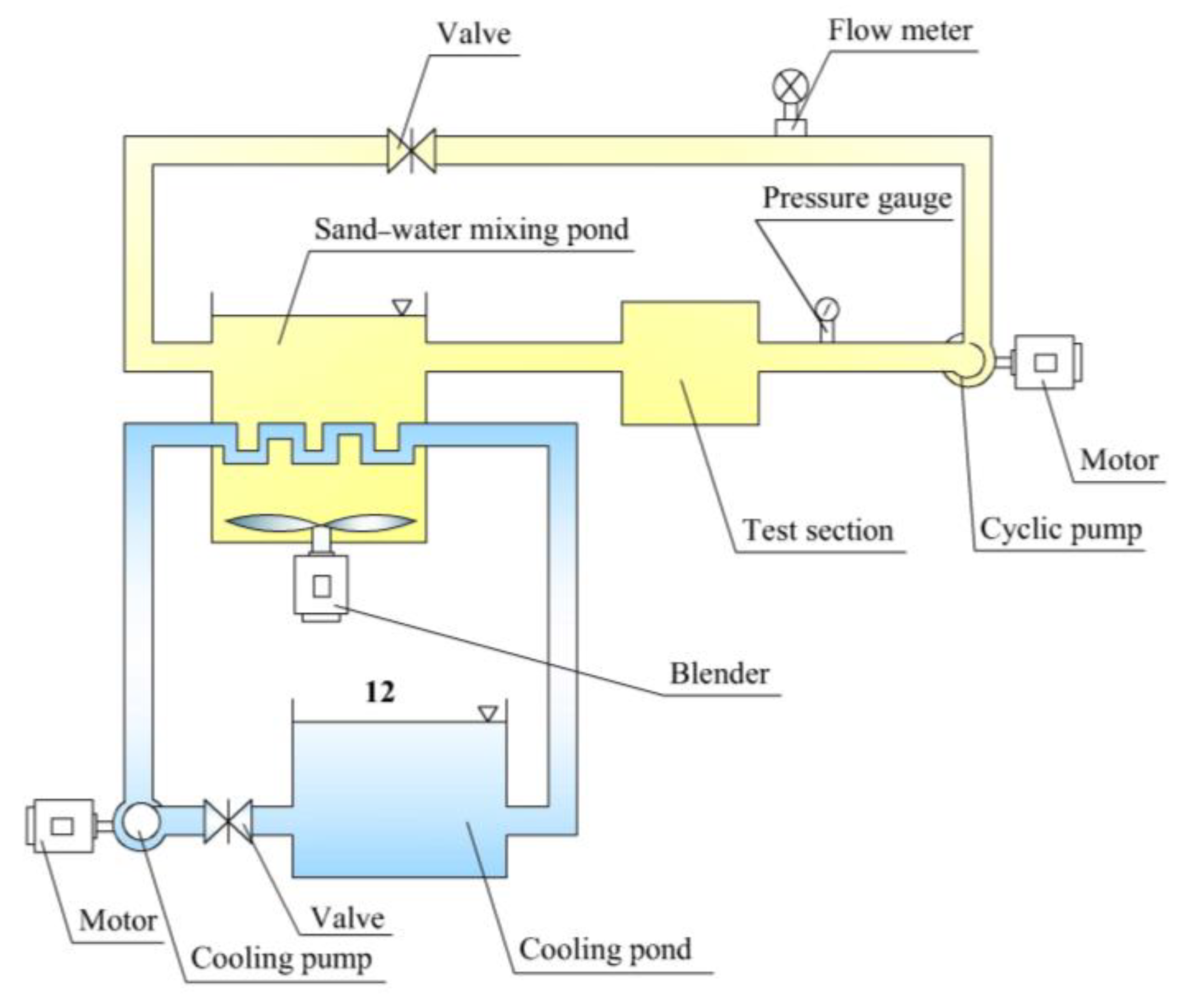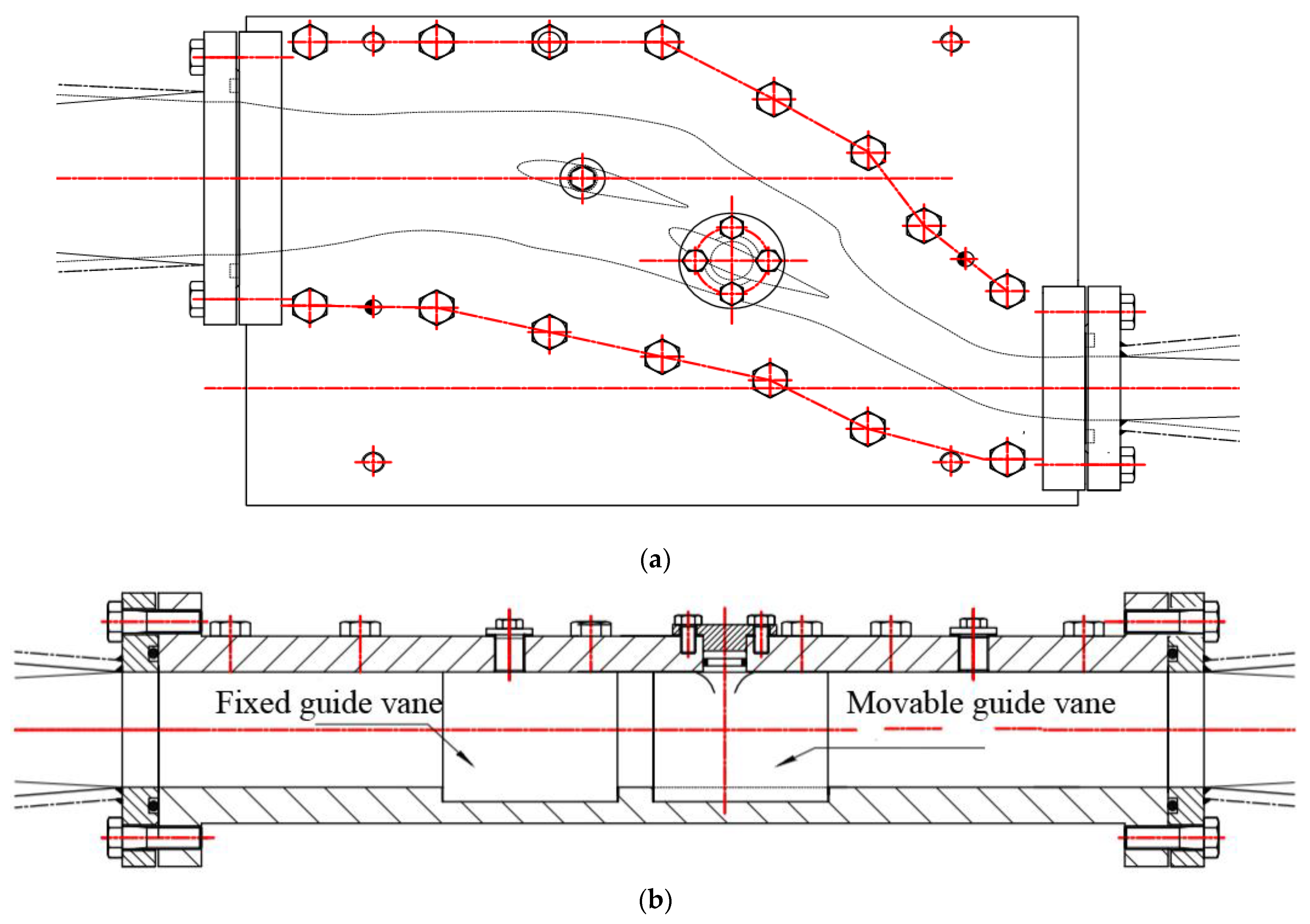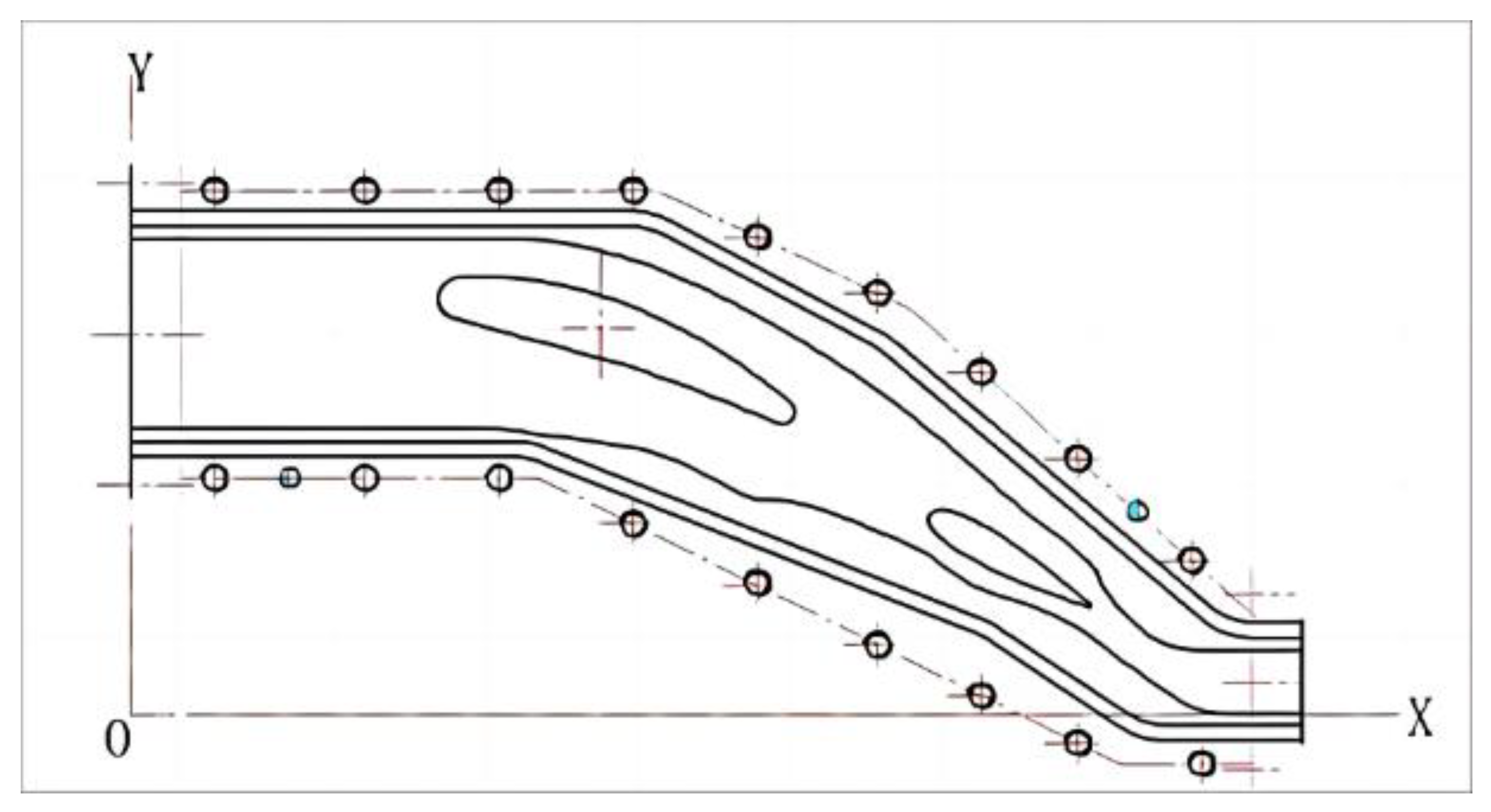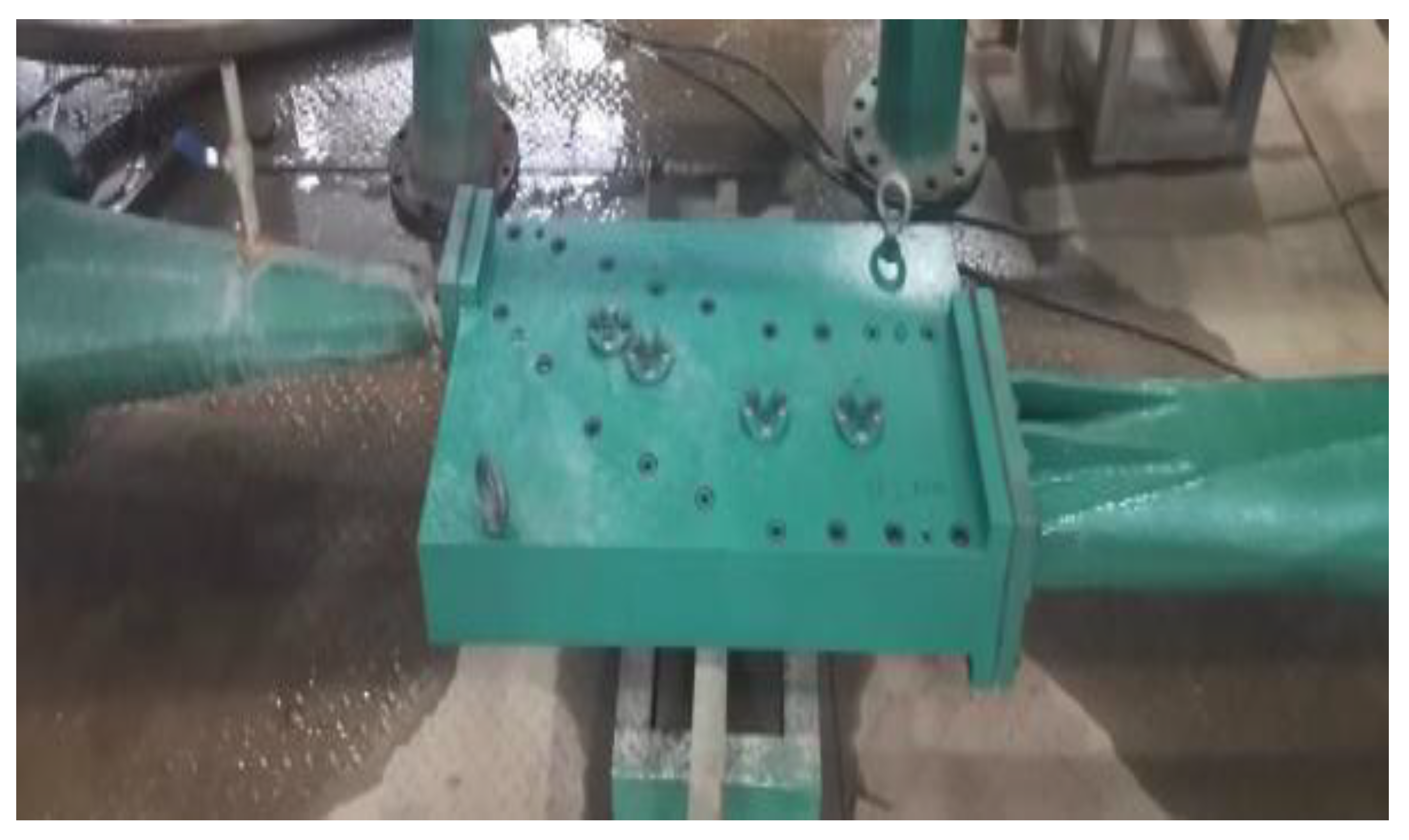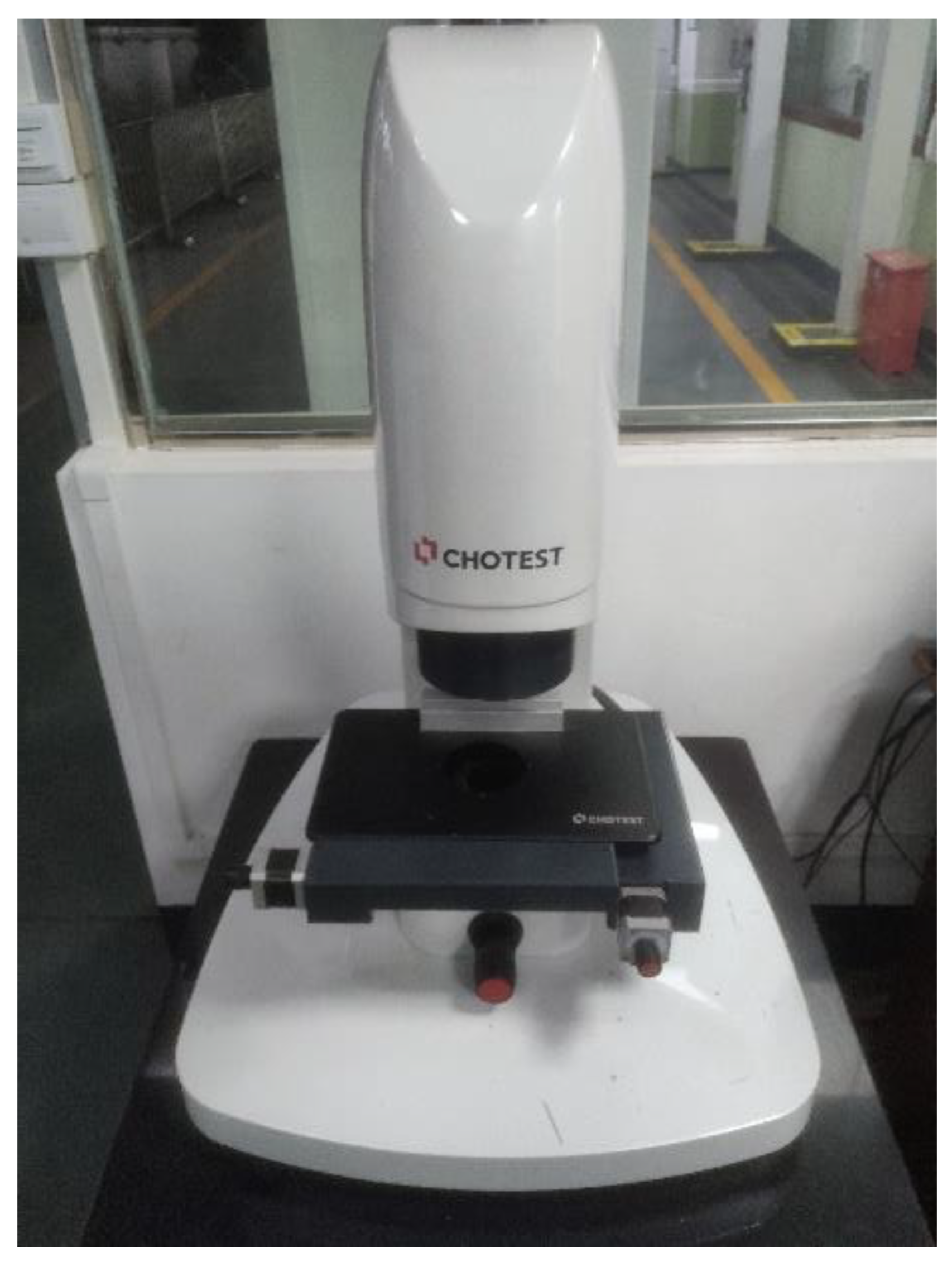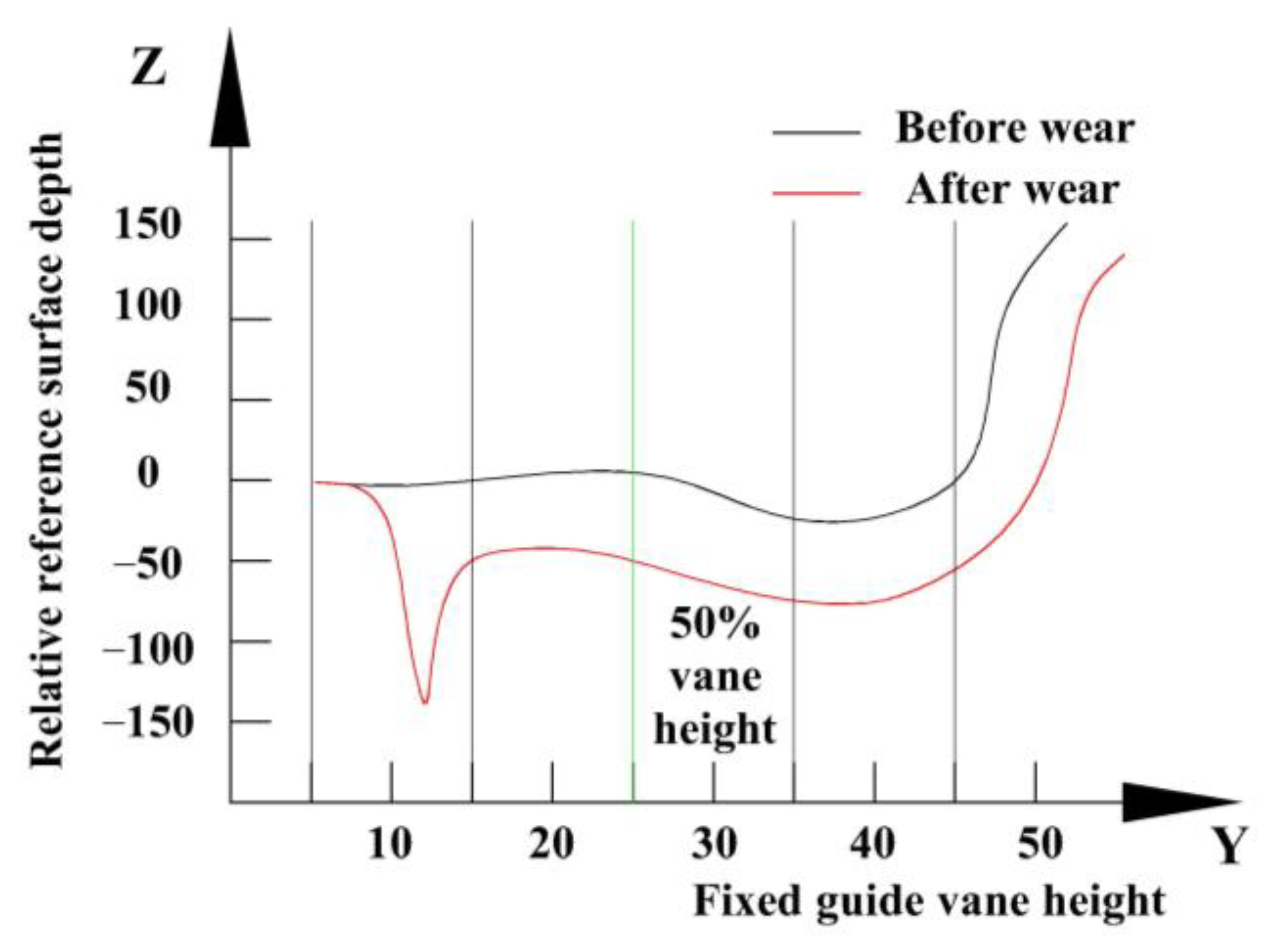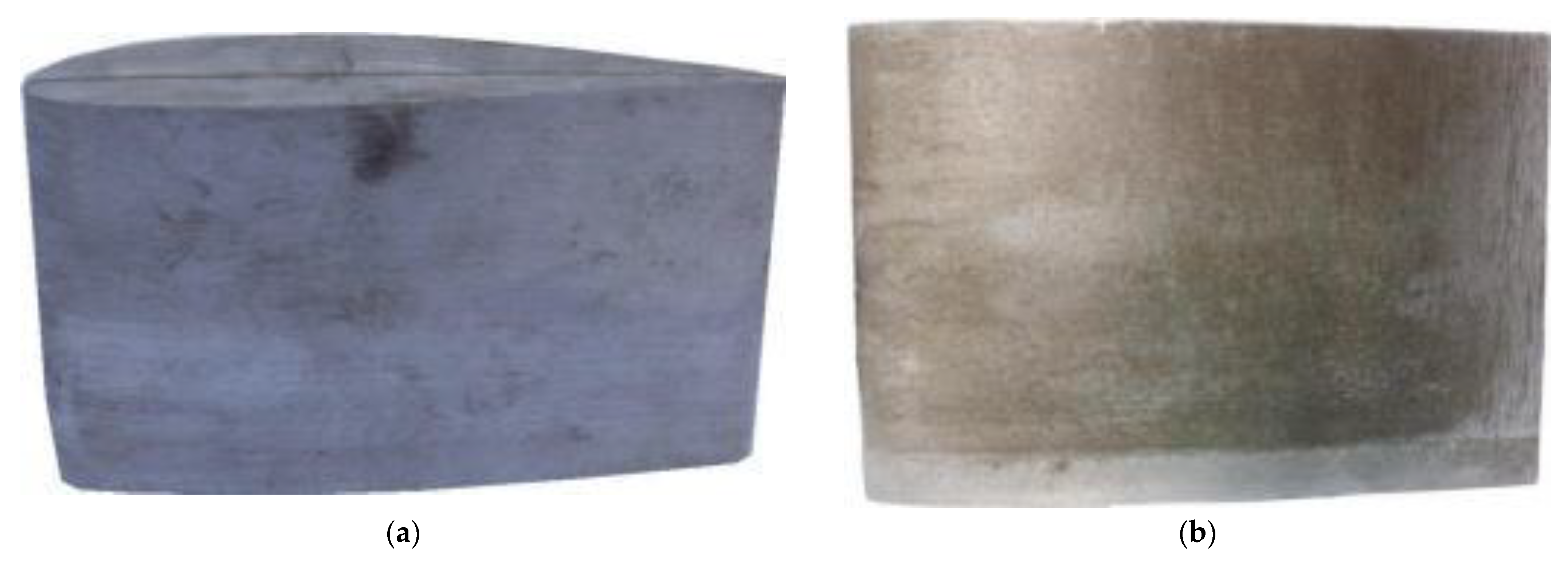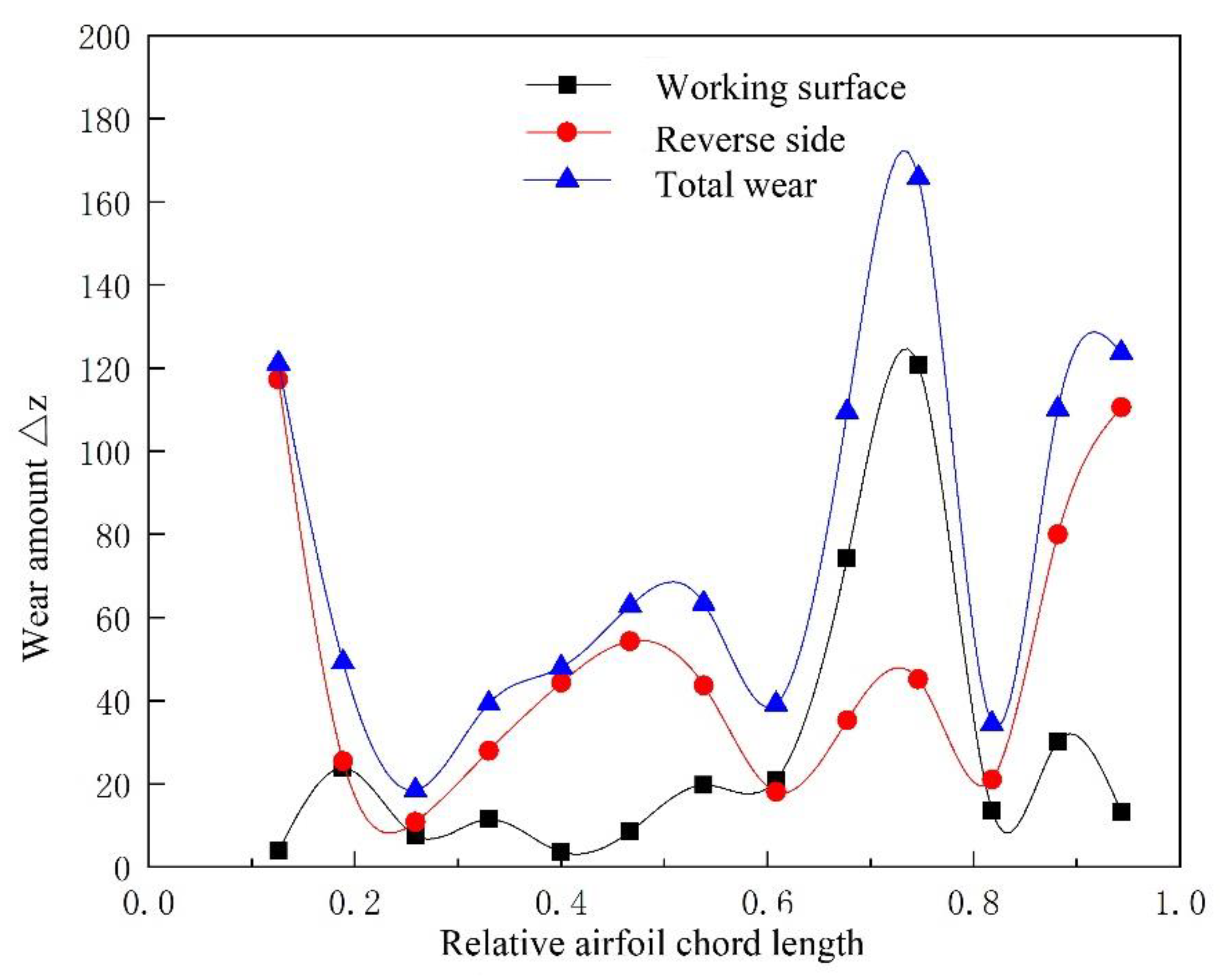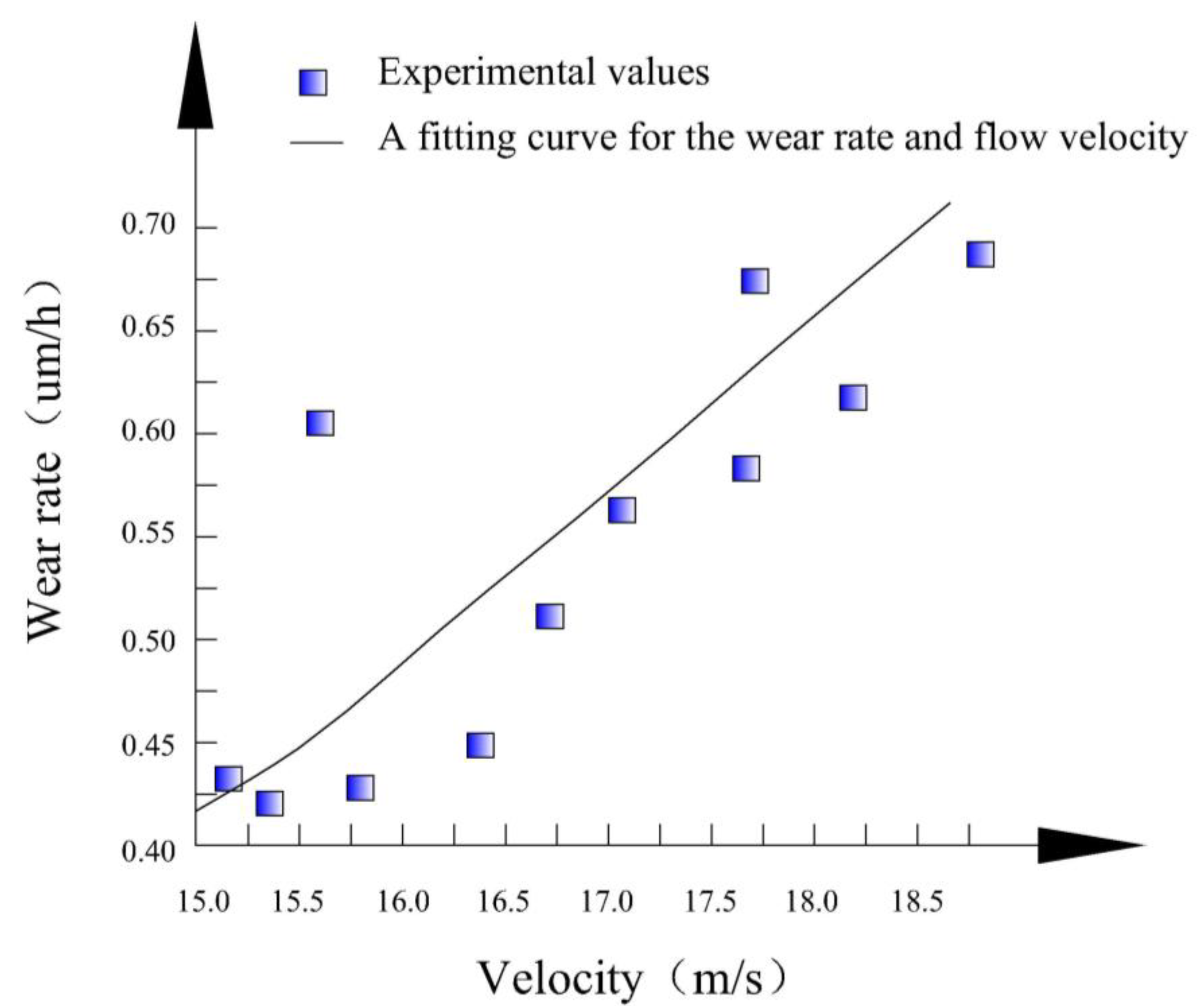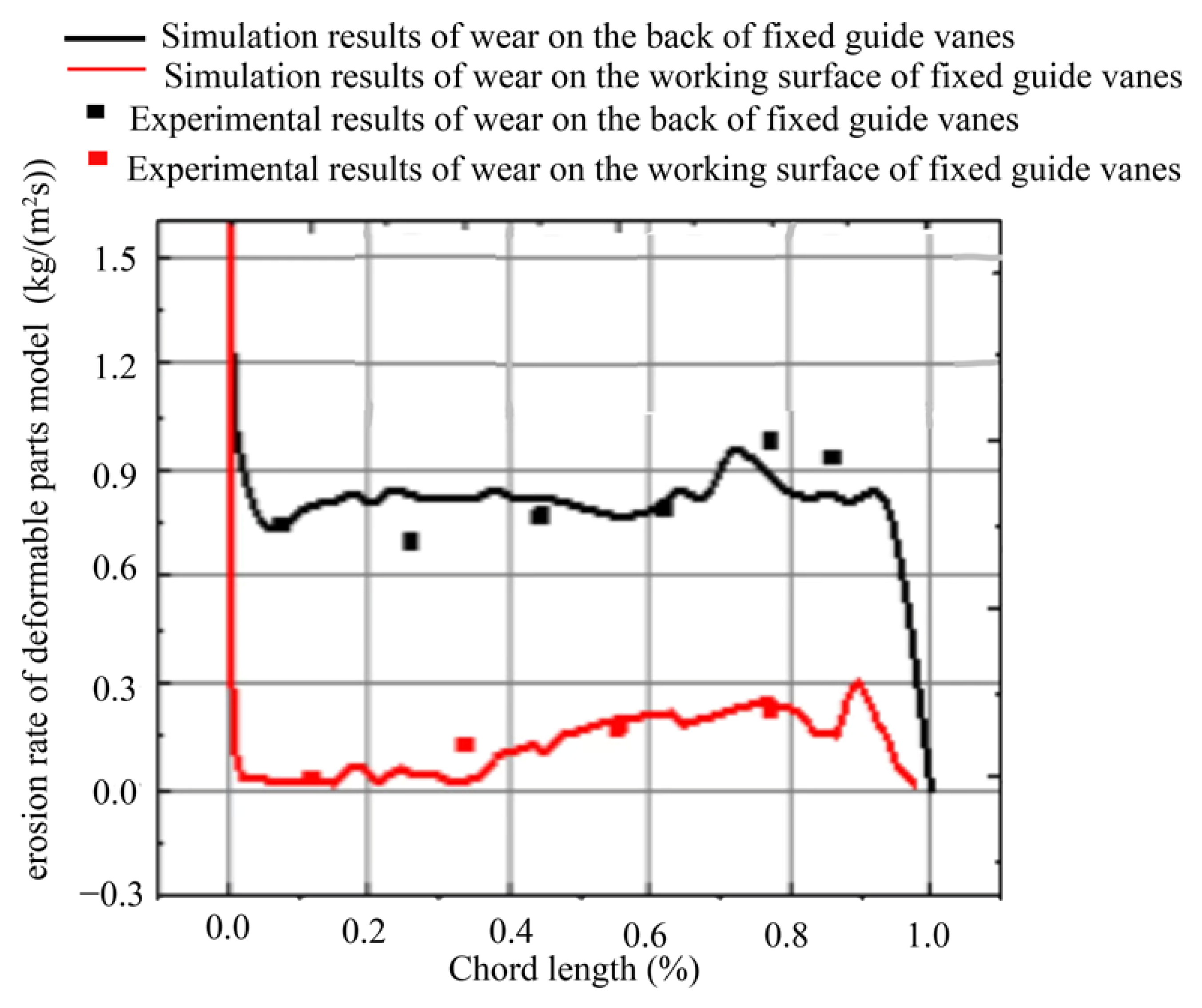1. Introduction
Many rivers worldwide contain high concentrations of sand and sediment, which inevitably leads to wear on hydraulic turbines. The damage to the turbine’s components exposed to the water flow results in decreased efficiency, frequent maintenance requirements, and unstable power supply. Consequently, the study of sand erosion in hydraulic machinery has garnered significant attention from scholars globally. This research aims to enhance the operational efficiency and stability of hydropower stations by conducting numerical simulations on a specific type of hydraulic turbine’s fixed guide vane. The simulation results are then compared with experimental data to validate the effectiveness of the discrete phase model (DPM) in simulating the wear on fixed guide vanes and to identify critical wear areas on their surfaces. Developing protective and maintenance plans against sediment erosion on fixed guide vanes is crucial for improving the operational efficiency and stability of hydroelectric power plants. Factors such as material selection, flow velocity, sediment content, and others must be taken into account.
In recent years, scholars worldwide have extensively studied various types of hydraulic machinery using DPM models. Sediment erosion on flow components of hydraulic turbines has gained widespread recognition among both domestic and international researchers through the use of numerical simulation methods. Scholarly investigations have revealed that sediment erosion on these components is primarily influenced by factors such as sediment particle size, flow velocity of sand-laden water, material selection for the flow components, and sediment content of the river in the power plant. Gongxiang Zhong focused on erosion and wear issues of a novel high-pressure manifold quick connect device used in ground-based well pads using the discrete element method (DPM) under the Eulerian–Lagrangian dual-fluid model. The study identified the erosion concentration locations of the device and factors affecting erosion size [
1]. Zuobing Chen et al. examined a vertical mill and employed a combination of experimental and simulation methods. They utilized the bidirectional coupling calculation method of the DPM to determine particle motion trajectories. The study analyzed velocity, pressure, and discrete phase distribution to investigate the interaction of two-phase flow, particle classification, and screening characteristics in the vertical mill flow field [
2]. Jiao Liao et al. conducted a comprehensive channel numerical simulation of a Francis turbine to analyze sediment distribution and solid–liquid two-phase velocities on the runner blade surface under different operating conditions. The study provided a theoretical basis for the hydraulic turbine’s transformation in the power station [
3]. Lei Xu proposed a discrete unit method based on the Euler–Raglansi dual-fluid model capable of calculating wear caused by discrete phases of varying particle sizes [
4]. Hongbin Liu employed the Fluent software DPM model to establish an erosion model for a three-way tube, obtaining erosion characteristics [
5]. Jingting Zhao and Jinxi Zhu investigated the flow behavior of solid–liquid two-phase flow in pumps, specifically examining the influence of blade inlet angle, particle diameter, density variation, and pump impeller auxiliary blades on particle motion trajectories and pump performance [
6]. Rennian Li and Yan Liu utilized two-phase flow theory and boundary theory to formulate a mathematical model for the boundary between a constant solid and fluid in two-phase flow [
7]. Yan Cao, et al. investigated the characteristics of water-conducting components in hydraulic turbines under the influence of sandy water flow using an experimental model setup. They identified the correlation between the relative positioning of fixed and movable guide vanes and the sand content [
8]. Xiaobing Liu and Liangjun Cheng, starting from the fundamental principles of fluid mechanics, analyzed the forces acting on solid particles within any flow field. They derived the motion equation for sparse solid particles, developed a numerical calculation method to solve particle motion, and established a solid–liquid two-phase turbulence model, a particle wear model, and an Eulerian–Lagrangian mixed turbulence model for water turbomachinery. Furthermore, they conducted numerical simulations to investigate sediment wear in hydraulic turbine machinery [
9].
Sheldon and Finnie conducted experiments and analysis, demonstrating that certain size and flow velocity ranges of impact particles can cause plastic deformation and exhibition of wear characteristics typically observed in flexible materials [
10]. Hashemisohi et al. employed a dense discrete phase model coupled with granular fluid dynamic theory and experiments to investigate the bubble characteristics and separation of multi-component particle mixtures in a fluidized bed [
11]. Jafari et al. examined the erosion wear characteristics of four different wear-resistant steel plates and developed a device to evaluate erosion wear rates of various materials under different slurry concentrations [
12]. Singh utilized water and ash as the continuous and discrete phases, respectively, in a solid–fluid two-phase system. The study explored the corrosion and erosion characteristics of bent pipes by analyzing factors such as speed, concentration, and particle size [
13]. Sato conducted experiments using impact jet devices in air and water, as well as rotating disk devices, to analyze different modes of material failure by examining surface wear under varying particle sizes, impact angles, and flow velocities [
14]. Padhy et al. performed experiments on small-scale bucket-type turbines and found that wear rates increase with sediment concentration when the impact of sand particle size is neglected. However, at constant sediment concentration, wear rates are directly proportional to sand particle size [
15]. Kenichi et al. utilized a jet erosion test apparatus to evaluate wear in different materials and coatings. Results indicated that variations in impact angle between 60° and 90° have a minimal effect on wear at higher velocities (e.g., 40 m/s), while at lower velocities (e.g., 10 m/s), wear decreases with increasing impact angle up to a certain value [
16]. Neppane [
17], using a test apparatus developed by Thapa [
18], investigated flow characteristics at the exit of axial flow turbine guide vanes and the inlet of the runner in a sand–water mixture. Findings revealed that particle trajectories deviating from streamlines during flow significantly impact wear. Moreover, larger particle sizes and higher concentrations lead to greater deviation from streamlines. Laouari et al. conducted research on steady and unsteady cavitation flow in a small-scale mixed-flow turbine using a two-phase mixture model. The researchers assessed the impact of a reduced cavitation number on hydraulic performance and determined the operating range for cavitation-free operation [
19]. Yonezawa et al. conducted numerical simulations to investigate the flow of solid particles and their erosion effects within labyrinth seals. The study observed that while increased leakage flow rates significantly disturb Taylor vortices, stable vortices still form within the central space regardless of the leakage flow rate [
20]. Noon et al. surveyed various techniques employed by researchers to mitigate slurry erosion and cavitation. They performed an economic analysis for a case study involving centrifugal pump (CP) usage in Pakistan, which demonstrated that an 8% improvement in pump efficiency can reduce the life cycle cost by approximately 17.6% [
21]. Dahlhaug et al. investigated the performance of a Francis turbine, specifically focusing on erosion-induced clearance gaps in the guide vanes (GVs). Numerical simulations using the GV and runner blade passages revealed that the clearance gap induces a leakage flow due to pressure differences between adjacent sides. This leakage flow mixes with the main flow, creating a vortex filament inside the runner. The asymmetrical profiles examined in the study exhibited improved erosion resistance, efficiency, and pressure pulsations in the runner. By incorporating non-uniform clearance gaps in the analyses, the influence of leakage flow on the runner can be more accurately studied [
22]. Thapa et al. investigated the impact of clearance gaps in GVs of Francis turbines, which contribute to total losses due to the formation of secondary flow within the gaps. The study concluded that clearance gaps of up to 0.5 mm (at 97 mm GV height) can be tolerated without causing significant losses in low specific speed turbines [
23].
Various experimental methods have been employed to study sediment erosion in hydro turbines, including jet impact, rotating container, vibration impact, rotating test specimen, sediment swirling, and local bypass methods. However, the accuracy of wear tests is often compromised by the limitations of current experimental devices and methods. It is crucial to simulate the actual flow conditions of hydro turbine components as closely as possible. Among the readily available experimental methods, the rotating wear test involves machining turbine components into various shapes, fixing them on a rotating disc, and examining the wear behavior of different materials at different rotational speeds. While this method is conceptually simple, it only provides information about the relationship between water flow velocity and material wear, lacking flow similarity. As a result, it cannot accurately estimate the extent and distribution of wear on hydro turbine components.
To address these limitations, this study introduces an innovative flow-around test method. The principle involves numerically simulating the complete flow field of a hydro turbine under different operating conditions to determine the flow distribution around the critical overcurrent component, specifically the fixed guide vane. This information serves as the foundation for designing a test apparatus that replicates the flow passage of the overcurrent component, enabling wear tests. This approach ensures flow similarity between the test specimen and the actual turbine, resulting in consistent results with real-world performance. It facilitates convenient analysis of wear patterns on the test specimen and offers improved precision compared with other wear prediction methods, ensuring alignment between the test results and actual outcomes. This innovative approach is a notable contribution of this research.
2. Mathematical Model
The Eulerian multi-phase flow model is capable of simulating the flow and interaction between multiple phases. In this model, each phase can represent a combination of gas, liquid, and solid, and the Eulerian method is applied to each phase. Theoretically, the Eulerian model can simulate any second phase as long as there is sufficient memory capacity. However, when dealing with more complex multi-phase flow problems, the convergence of the solution results can be limited.
In the Eulerian–Lagrangian dual-fluid model, particles are treated as discrete phases, coexisting as a continuous medium. This study utilizes the K-ε model to simulate the turbulent flow of the liquid phase. It assumes that the inner flow field consists of only a clear water phase (continuous phase) and sediment phase (discrete phase), with stable physical properties for both phases. The granular dynamics method is employed to simulate the flow of the discrete phase particles, while numerical analysis is used to study the flow characteristics of a specific type of hydraulic turbine when the fixed guide vane is in operation. In the calculation of the two-phase flow, the water phase is first solved under the Euler coordinate system, which involves solving the control equations for the continuous phase. Once the calculation converges, the discrete phase particles are injected into the flow field, and then the discrete phase is solved under the Lagrangian coordinate system to obtain the flow characteristics of the discrete phase particles.
2.1. Continuous Phase Control Equation
Since there is no mass transfer between phases, the conservation equation for continuous phase quality and the dynamic equilibrium equation can be described as follows:
where
is the phase fraction of the continuous phase;
is the density of the continuous phase;
is the average velocity of the continuous phase;
denotes the stress tensor;
p is the average pressure;
g is the gravitational acceleration vector; and
A is the momentum interface exchange term.
2.2. Discrete Phase Control Equation
In the movement of the flow field, discrete phases primarily experience drag, gravity, buoyancy, and collision forces among themselves. Due to the significant differences in magnitude between gravity, buoyancy, and collision forces within the solid phase of the liquid phase, this research primarily focuses on the drag force, while neglecting the other forces. Since the discrete phase model does not take into account collisions between discrete phases or the volume of the discrete phase itself, the movement of the discrete phase can be described as follows:
where
is the mass of the discrete phase;
is the discrete velocity component along the
x,
y, and
z directions;
is the component of the drag force in the discrete phase in the
x,
y, and
z directions;
is the discrete phase mass density; and
gx,
gy, and
gz are the components of gravitational acceleration in the
x,
y, and
z directions, respectively.
2.3. Wear Model
The general wear model used in the DPM model is as follows [
24,
25]:
where
C(dp) is a discrete phase diameter function;
is the impact angle between the discrete phase and the wall surface;
is the discrete phase velocity;
is a function of relative velocity; and I is a function of impact angle.
4. Experimental Study on Sediment Wear Characteristics of Fixed Guide Vanes of Hydraulic Turbines
Sediment concentration in rivers is a common occurrence, and hydraulic turbines worldwide face challenges related to sediment wear. The main steps of the flow-around wear test are outlined as follows:
Step 1: Ensure that the sediment concentration of the test sand aligns with the actual discharge of the power station. Based on the three-dimensional numerical simulation results of a prototype hydraulic turbine, the flow conditions of a single channel within the turbine’s water guide mechanism are analyzed. The flow lines around the flow passage are extracted to define the flow boundaries, and a test piece resembling the flow passage components of the real power plant is designed, specifically for the fixed guide vanes.
Step 2: Adjust the parameters and selection criteria for the sediment, such as particle size and the actual operating conditions of the hydropower station. Fine-tune the water-to-sand ratio and flow rate in the test system accordingly. Conduct the abstinence and wear test, allowing a sufficient duration for the test to take place. Once completed, remove the test parts and utilize a white light interference contour meter to measure the surface wear depth and appearance. Utilizing the multi-linear analysis method, establish the wear equation and associated indices.
The equation for sediment wear rate can generally be expressed as follows:
where
is the wear rate (the wear depth per unit time of the surface material of the flow passage component) (µm/h);
k indicates the coefficient of sediment particle characteristics, material characteristics of flow passage components, and other influences;
ϕp is the sediment volume fraction on the surface of the flow passage components, which are related to the sediment concentration or sediment concentration
CV at the inlet of the hydraulic turbine, the geometric shape of the flow passage components of the hydraulic turbine, the operating conditions of the hydraulic turbine, etc.;
W is the relative velocity of sand water or sand particles impacting the surface of the flow passage component (m/s); and
n is the speed index.
Step 3: Utilize the numerical calculations to extract the velocity and concentration distribution data for crucial components of the hydraulic turbine. Subsequently, incorporate these data into the quantitative wear rate equation to make predictions regarding the wear condition of the hydraulic turbine.
4.1. Flow-Around Wear Test
The experimental setup comprises the power system, cooling system, sediment mixed system, and test section, as depicted in
Figure 16. The maximum power capacity of this experiment is 630 kW, with a sand pool volume of 30 m
3. The system employs stainless steel pipes with a diameter of
ϕ 200 mm and operates at a pressure of 376 m water column. The rated flow rate is 482 m
3/h. To achieve a homogeneous sediment mixture, the sediment mixed system utilizes a water pump for impact and stirring. For cooling purposes, a snake-shaped tube is employed to extract groundwater. The test site is illustrated in
Figure 17.
The test section plays a crucial role in the experimental setup. In the case of the fixed guide vane of a specific type of hydraulic turbine, the test section is constructed using Q345 carbon steel. To align with the flow field profile obtained from numerical simulations, the test section undergoes CNC machining to create water channels with a depth of 40 mm for the water guide mechanism under various operating conditions. At the bottom of the flow channel, a groove with a depth of 6 mm is milled to accommodate the installation of the guide vane, ensuring a snug fit between the guide vane and the groove.
Figure 18 presents a sectional machining drawing of the working section, while
Figure 19 shows a single passage diagram for the guide vane wear test section. Additionally,
Figure 20 provides a physical photograph of the test section box, and
Figure 21 displays pre- and post-installation photographs of the guide vane in the test section.
The key characteristics of sediment particles found in the power station are presented in
Table 2. Additionally,
Table 3 displays the particle grading of suspended sediment samples, while
Table 4 provides the mineral composition analysis. The density of quartz ranges from 2.5 to 2.8 g/cm
3, typically averaging 2.65 g/cm
3. Calcite has a density of 2.60 to 2.8 g/cm
3. Feldspar has a density of 2.55 to 2.57 g/cm
3, and chlorite has a density of 2.65 to 2.9 g/cm
3. To ensure similarity between the working conditions of the fixed guide vane for a specific type of hydraulic turbine and the experimental setup, a sand sample from the power station is utilized. The power station’s sand sample contains a maximum sand content of 9.52 kg/cm
3. The fixed guide vane is made of Q345R material, and its boundary conditions align with those employed in the numerical simulation.
4.2. Numerical Treatment of Sediment Abrasion Test for Fixed Guide Vanes
In this study, the depth test method is employed to assess the specific location wear on the surface of the test specimens in order to quantify sediment wear. Prior to conducting the tests, the surface measurements of the vanes are marked at specific positions, ensuring that the same locations are measured before and after the test to accurately assess wear. The positions of the test specimens are determined based on the coordinates shown in
Figure 22: The
x-axis represents the string line direction in the side view of the vane, the
y-axis indicates the height direction at the edge of the vane, and the
z-axis represents the surface height of the guide vane.
The instrument used to measure the wear depth and surface morphology of the test specimens is an advanced white light interference profiler (
Figure 23). This instrument operates based on the principle of comparing the deviation of the test surface from an ideal reference surface using interference fringes. It is a high-speed, non-contact wear testing device with a measurement accuracy of 0.1 nm.
The test component is aligned with the reference point, and the position of the probe and testing stage is calibrated using the corresponding control software on the computer. Subsequently, data are collected and processed using the image acquisition system to determine the wear depth on the surface of the guide vane. The surface profiles before and after wear are measured using a white light interferometer. The wear at each position is calculated as the average difference between the working surface and the back surface at the corresponding chord length position.
Figure 24 illustrates the process, where the heights of the surface at the testing positions before and after wear, denoted as z
1 and z
2, respectively, are measured using a white light interferometer. The difference between z
1 and z
2 represents the wear depth of the surface.
Although sediment wear serves as the fundamental design criterion, the test box introduces slight variations compared with the multi-vane flow in the actual machine. Additionally, the presence of gravity affects the test part near the upper and lower end surfaces due to sedimentation. To obtain more accurate wear depth data and mitigate these influences, the surface measurements near the 1/2 guide vane height are considered as the test results in this study.
After conducting a 48 h fixed guide vane wear test, the front wear and rear wear are depicted in
Figure 25. The average values within the 40% to 60% range of the blade height at the working surface and back are taken. To minimize the impact of sidewall effects, it is advisable to select 50% of the blade height. A wear distribution map is generated using a total of 26 data points, as illustrated in
Figure 26. It is evident that the combined wear on the working surface and back of the movable guide vane exceeds 40 µm, with a maximum total wear of approximately 170 µm occurring at around 0.7 (near the tail) relative to the wing strings. Furthermore, the working surface of the fixed guide vane experiences a float of approximately 20 µm, while the back exhibits mostly greater wear than the working surface due to higher circumferential speed.
4.3. The Wear Rate Quantitative Equation Is Determined
The wear rate is calculated using the equation E = KCVWn, where E represents the wear depth per unit time, given by E = (z1 − z2)/t. The relative sand flow rate (W) at the test position of the test parts is obtained from the numerical calculation results. Therefore, when sorting the data, the parameter that requires velocity is represented by index n and coefficient K.
To determine the wear rate E (µm/h), the wear amount is divided by the test duration. The velocity and wear rate of each test location are then fitted in Origin using a non-linear fitting method, specifically the Allometric function type, and the iterative algorithm for orthogonal distance regression (Pro). This process yields a fitting curve for the wear rate and flow velocity, as depicted in
Figure 27.
The sand content (C
V) is measured as 9.52 kg/m
3, and based on this, the setting coefficient K and index n in the equation are calculated for the test parts, as shown in
Table 5.
6. Conclusions
This research paper proposes a method to estimate the wear of movable guide vanes in hydraulic turbines using a flow-through test apparatus. The accuracy of the method is validated through comparison with numerical calculations.
Firstly, the wear distribution pattern of fixed guide vanes under design conditions is obtained through numerical simulations. This provides valuable information for the timely maintenance of the turbine.
Secondly, a test apparatus is established to simulate the internal flow conditions of the actual turbine. The test rig is scaled down proportionally, and a single fixed guide vane is studied. Experimental results demonstrate similarity between the severely worn areas of the fixed guide vane and the simulation results. This validates that the wear rate of the fixed guide vane in the hydraulic turbine generally follows the wear equation based on flow velocity and concentration.
Thirdly, the DPM is used to conduct a two-phase flow simulation on the fixed guide vanes. This allows for the determination of the wear rate and velocity distribution of the guide vanes. The simulation results align well with the experimental results, indicating the effectiveness of the DPM model in simulating wear in the flow-through components of hydraulic turbines.
Lastly, this technology has been successfully applied in the design, manufacturing, and operation of wear-resistant hydraulic turbines at Xia Te Power Station in Xinjiang. Situated in a region with sediment-laden rivers, the power station has undergone one year of actual operation. Comparative analysis with similar power stations in the area confirms that the overall condition of the turbine’s runner, guide vanes, and other critical flow-through components at Xia Te Power Station is satisfactory, meeting the design and operational requirements for safe and stable unit operation.


